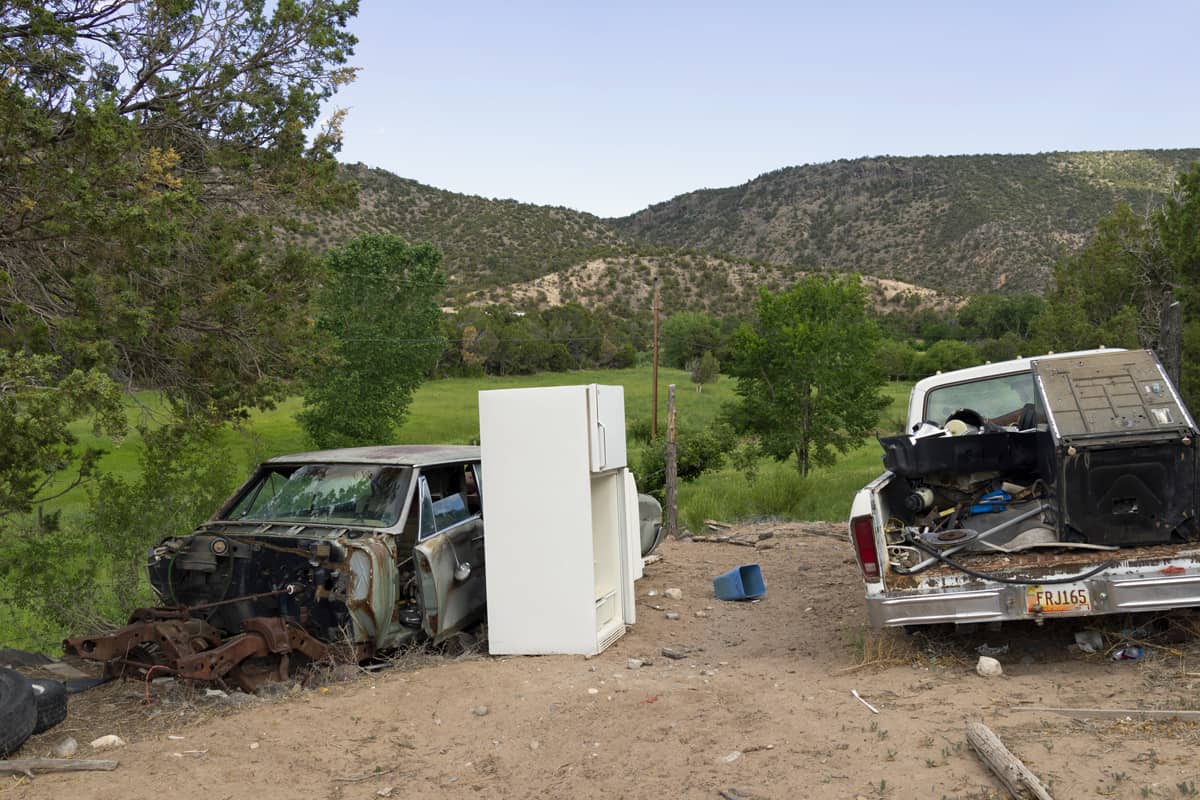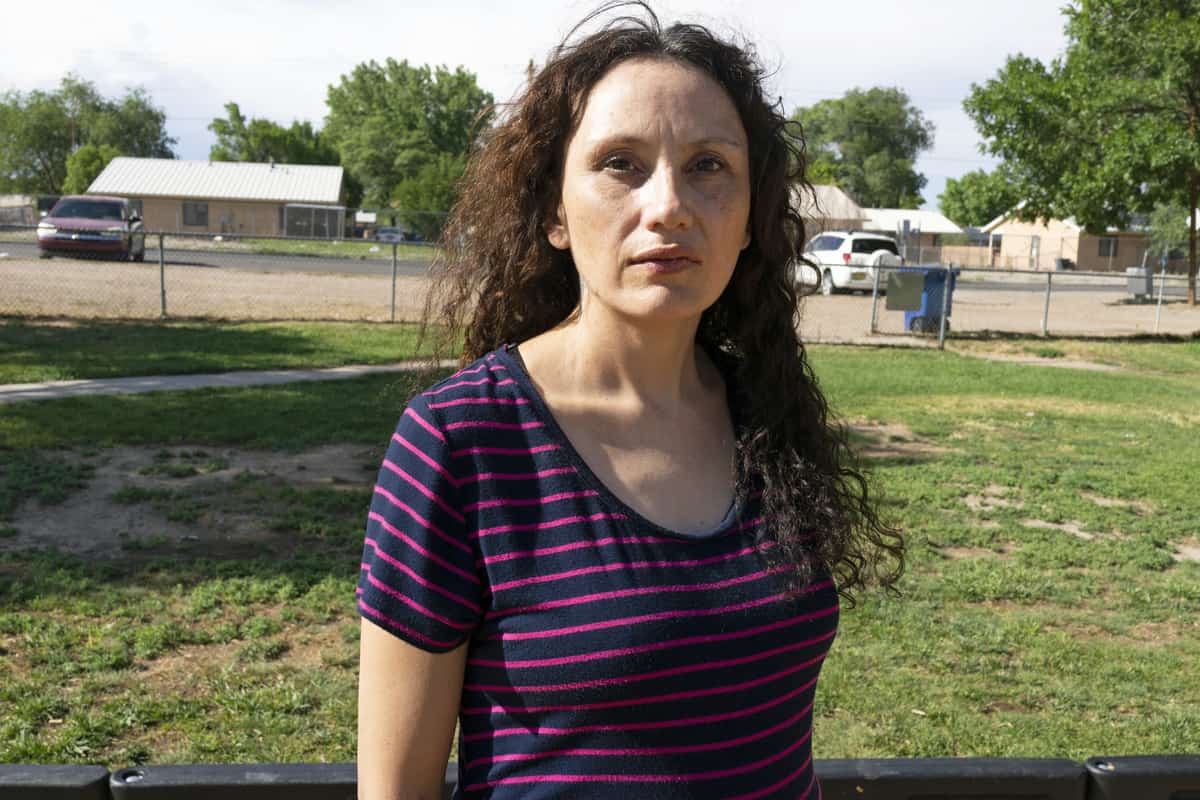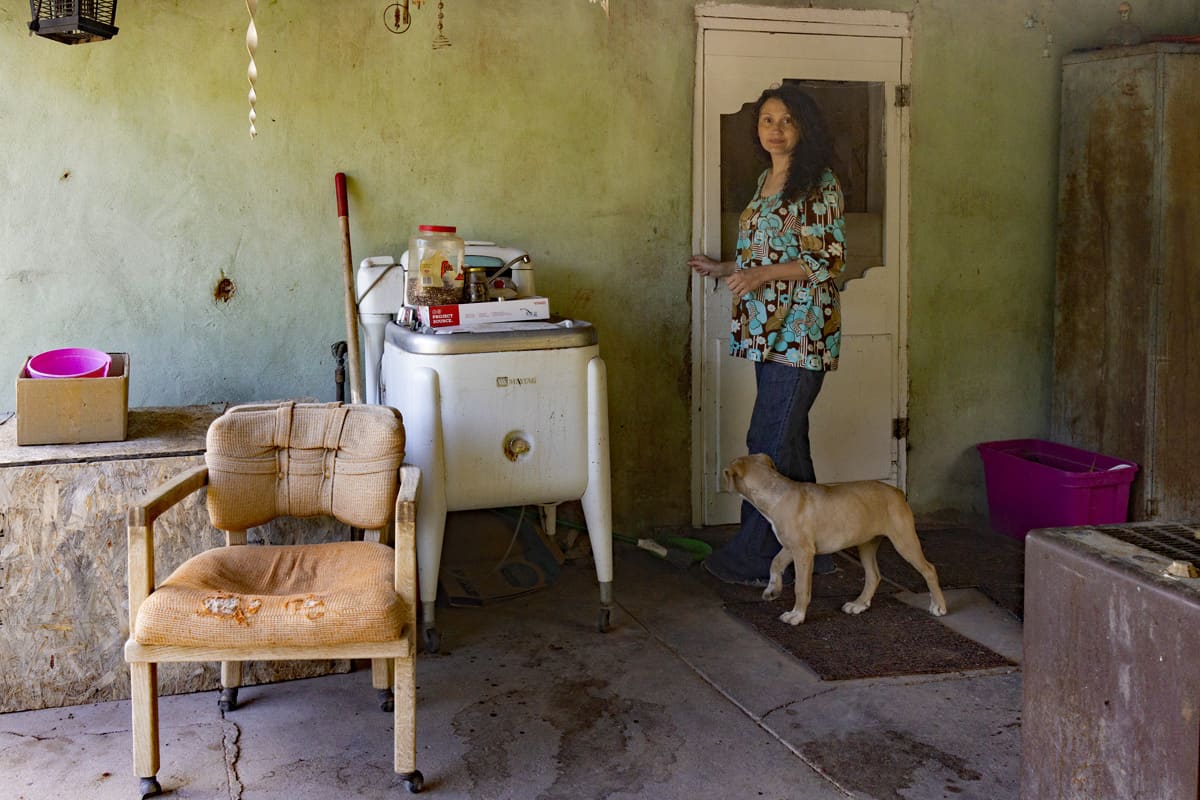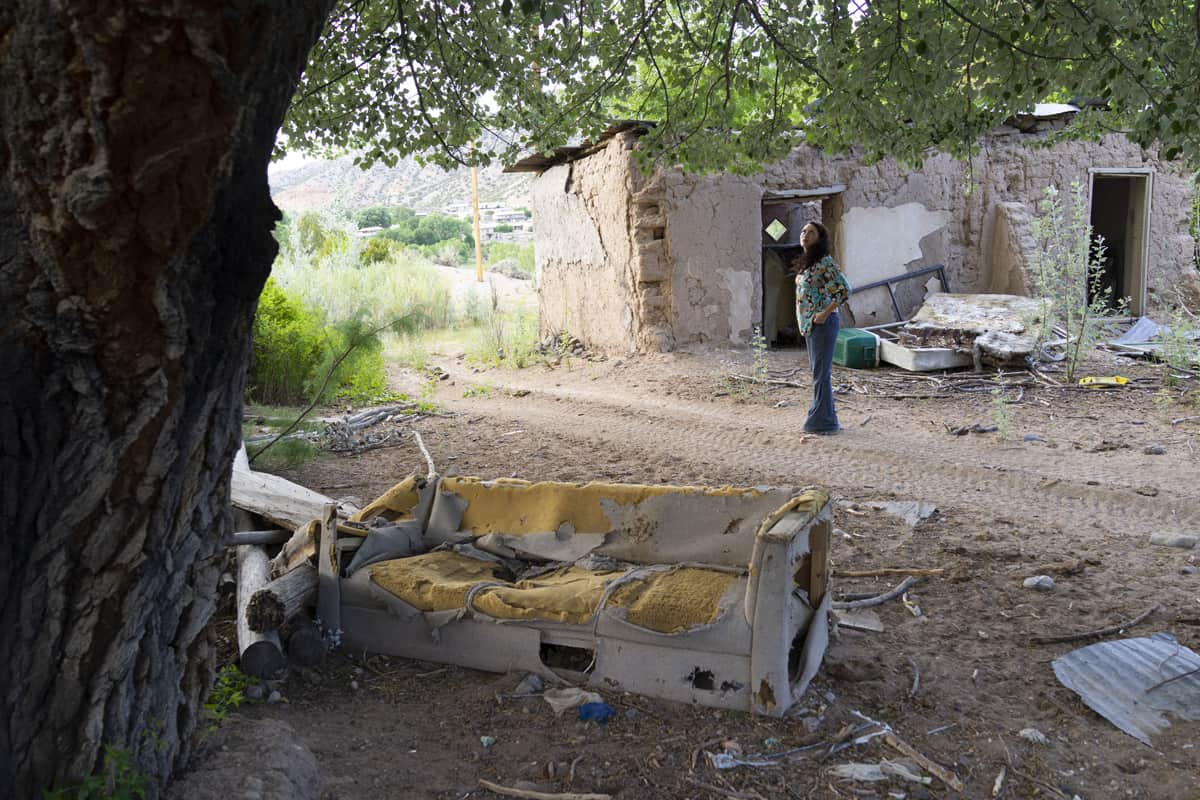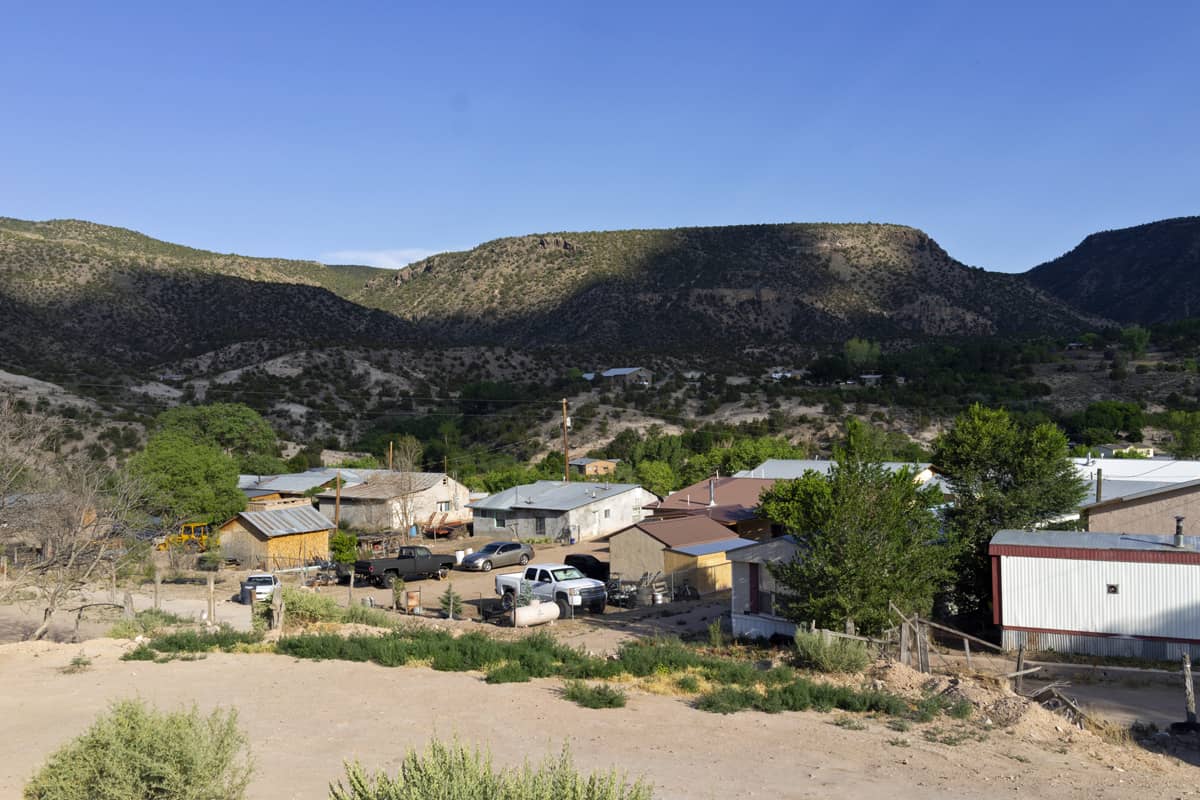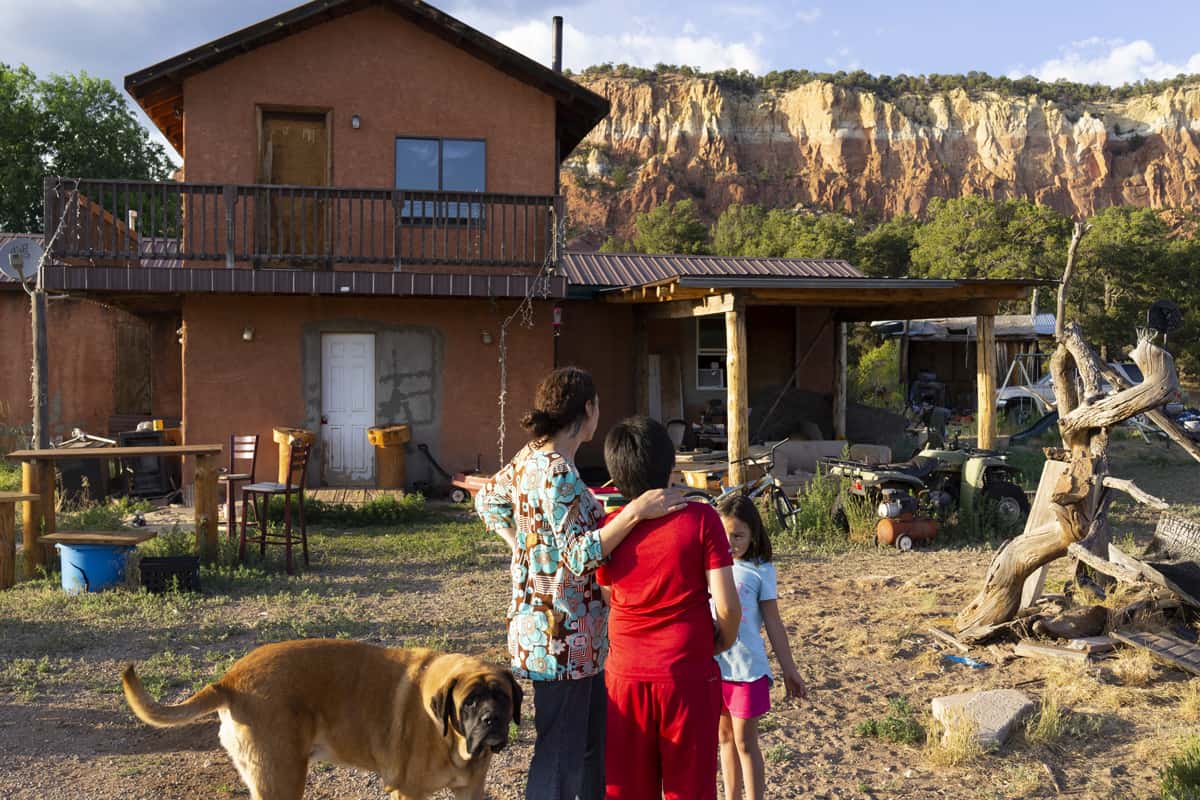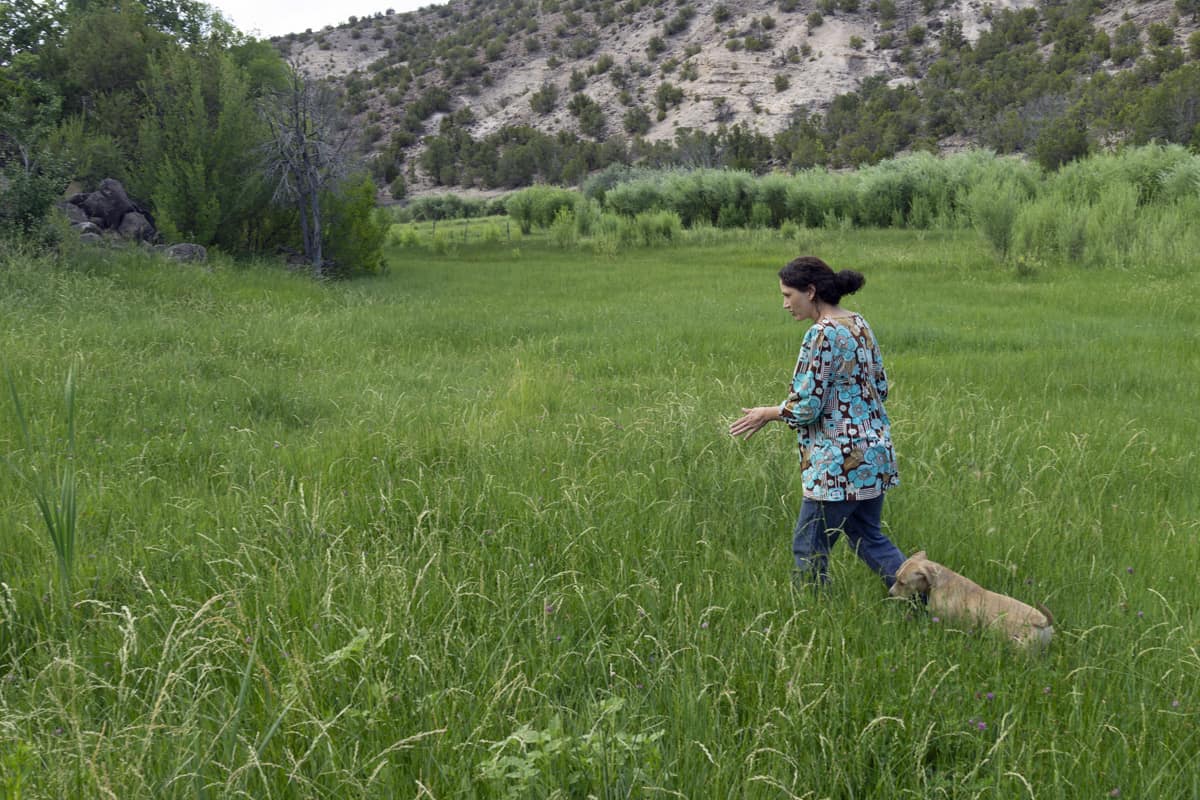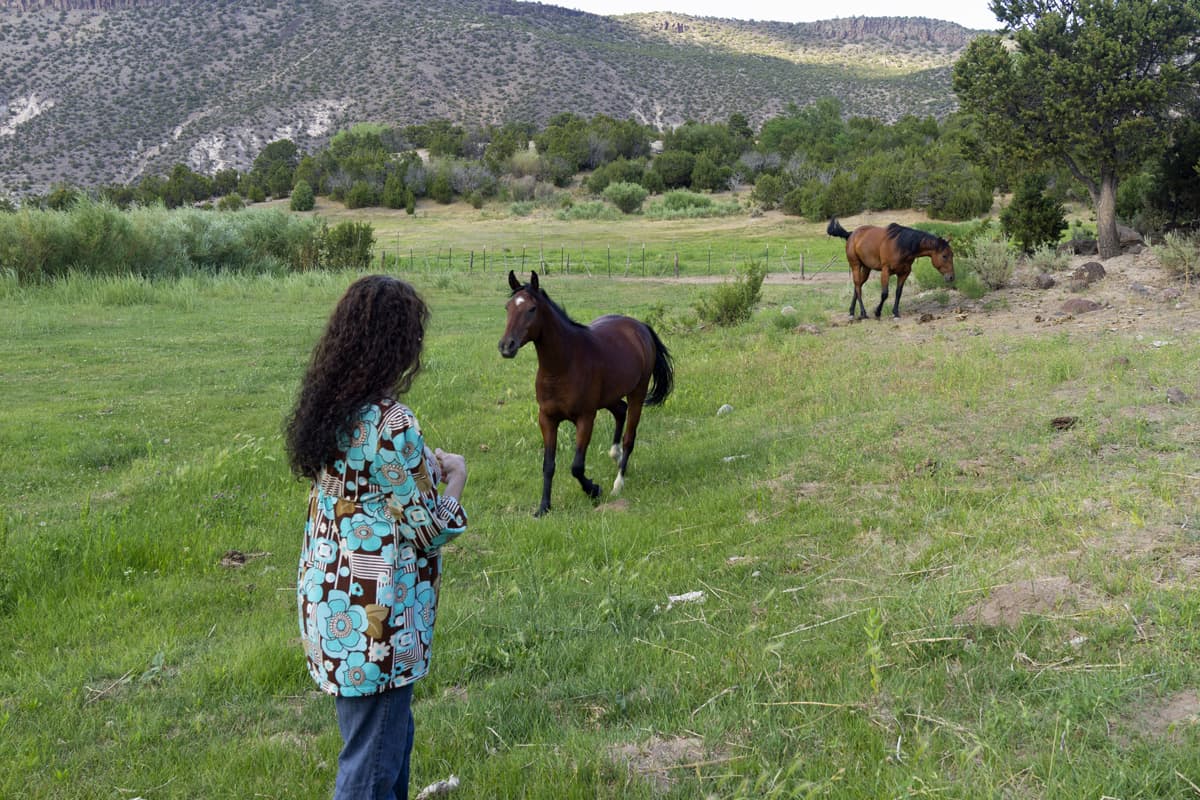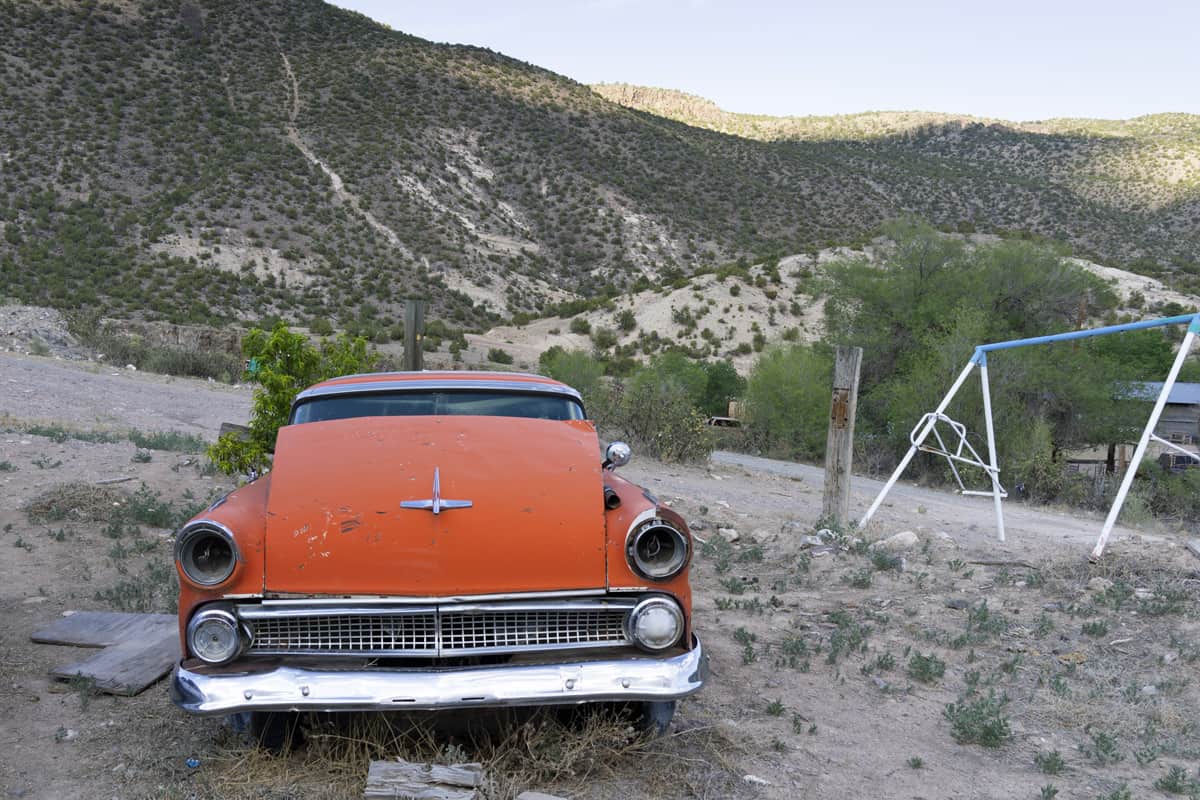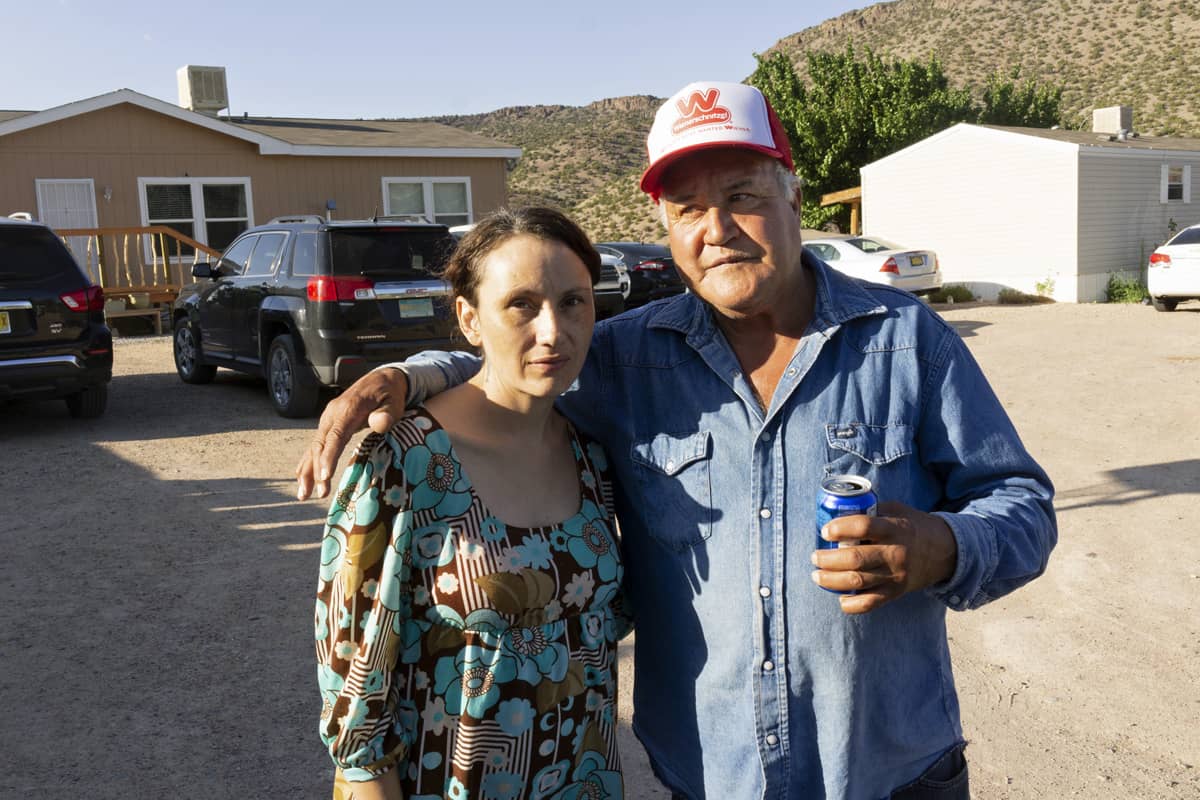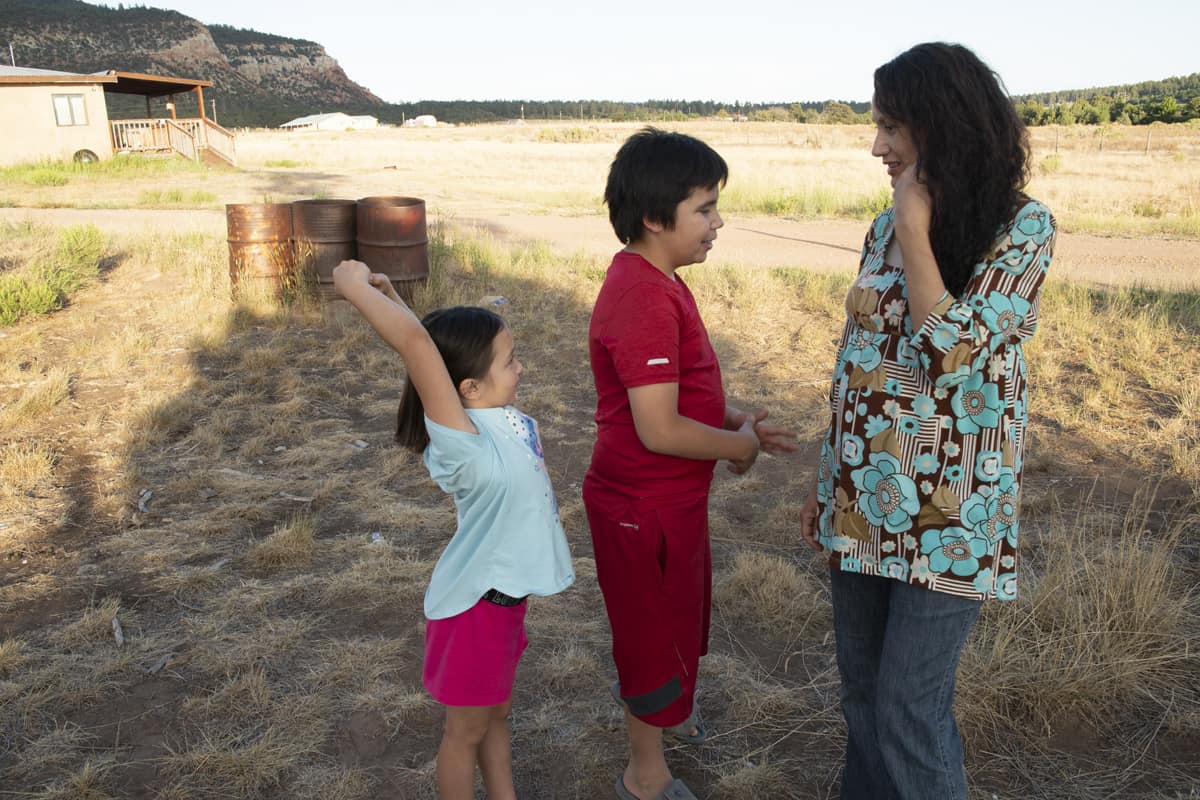
Don Usner / Searchlight New Mexico
Emilia in Cañones.
In Northern New Mexico, family roots and troubled histories run deep
PHOTO ESSAY: Photographers and writers have for the past 20 years journeyed to Northern New Mexico to chronicle the opioid epidemic. Images of strung-out tecatos, or heroin addicts, needles jammed in tattooed forearms, syringes piled in gutters, families weeping over gravestones: Long before the opioid abuse became a national scourge, these images and stories served to define Rio Arriba County as the heroin capital of the country — a place that is my querencia, my home of the heart.
I grew up dividing my time between Chimayó — known as one of the most notorious of the drug-plagued communities in the region — and Los Alamos, the lofty city on the hill, notorious for decidedly different reasons. I lived in Chimayo for 15 years, writing and taking photographs that vaunt its cultural riches, but I always avoided what many regard as an existential threat to the stability of the region.
Not that I was oblivious to it. I witnessed the domestic violence and alcoholism that ran through families. My home was robbed twice by people seeking goods to sell for drug money, and I employed laborers who had needle tracks up and down their arms. Overdose deaths were almost commonplace, as were shootings over drug deals gone bad.
I watched as children caught up in the turmoil repeated their parents’ behaviors. My wife, an infant mental health specialist, works with babies and young children who bear the emotional, psychological and neurological scars from exposure to drugs, abuse and neglect. She has for years returned home at night depleted by the narratives of trauma and addiction that repeat themselves across generations.
Still, I avoided entering into this world with my camera or pen, even as catastrophe unfolded around us. And then I lost someone I loved to a drug overdose, and there was no consolation.
I began to ask hard questions and ventured into neighborhoods I once avoided. I came to know people whose lives had been disrupted or destroyed by drugs. I discovered a core of human goodness in troubled places, and it struck me as one of the great ironies that such darkness persists amidst such a culture of deep-rooted familial strength.

Don Usner / Searchlight New Mexico
Emilia at her grandma’s house in Cañones.
I see that paradox in Emilia, a young woman who shares with me a strong connection to extended family in rural New Mexico. At 36, she is raising her fifth child, Daniella, while pregnant with her sixth, even as she fights an addiction to opioids. Six months in a residential program at New Mexico Women’s Recovery Academy in Albuquerque set her on a path to a clean life a year ago, and she is now enrolled in a medication-assisted substance abuse treatment program in Santa Fe that includes regular physician visits at La Familia Medical Center. Yet she has relapsed into heroin use more than once during this pregnancy.
Emilia knows what is at stake. Daniella, now 2 years old, experienced the trauma of heroin withdrawal at birth, and the memory of her pain still haunts Emilia. She takes buprenorphine, a prescription medication that serves as a safe substitute for heroin and lessens the risk to the fetus. But there is no guarantee that its use is risk-free.
In letting me into her life, Emilia insisted that I accompany her to her childhood village of Cañones, a placita of about a hundred people, an hour or so north of Española. It was as if she were saying, “If you want to know me, this is where you have to begin.”
When I picked Emilia up at the public housing development where she now lives in Española, a police car was parked outside. An officer was handcuffing a young man while a woman pleaded and stuffed bottles of prescription drugs into her purse. As I watched from Emilia’s porch, another young man approached. Gesturing to my camera, he asked if I could show him how to use the expensive new Canon that he happened to be carrying. In return for my help, he offered to show me some “really heavy things, like junkies shooting up,” suggesting that I come back at night for the best opportunities.
I was shocked to realize that the crisis of drug abuse in Rio Arriba is seen almost as an opportunity for cunning people like him. It was as if he were a tour guide to the underbelly of Española, hawking access to scenes of decadence.
It was a relief to leave Española and drive through Hernandez, past the spot where Ansel Adams took his iconic photograph of the cemetery and church now obscured by a jumble of mobile homes. We sped through Abiquiu, below Georgia O’Keefe’s spare adobe home, and wound through the shimmering stone landscape of the sun-beaten Piedra Lumbre Land Grant, a withering remainder of the vast estate that for generations sustained Emilia’s ancestors in this arid land.
And there they were: the emerald-green fields, irrigated by acequias that her grandfather and now her father maintained; her grandmother’s rambling old adobe home, where the woman lay napping beneath a handwoven blanket; the ramshackle chicken coop; and the corrals holding horses like those the young Emilia once rode.

Don Usner / Searchlight New Mexico
Emilia in Cañones.
As a child, Emilia clearly found in Cañones some of the same magic I knew from Chimayó. But while my rose-colored engagement has lasted a lifetime, Emilia’s childhood play was cut short. Like many placitas of New Mexico, Cañones is littered with historic relics, and she showed me one of these treasures, a still-standing molino, a kind of grist mill common in Northern New Mexico from Spanish Colonial times until the mid-20th century. For me, molinos exist in academic journals or in the memories of old people like my grandmother. Seeing an actual molino kindled in my imagination images of those days. But for Emilia, the molino was just an old building where she retreated as a child to escape the fights and beatings in her home.
We explored a soterrano, another type of historic building almost absent from the modern landscape. Emilia remembered her grandparents using this root cellar to store dried meat, potatoes, carrots, cabbages and apples, and she recalled the crispness of an apple her father retrieved from here one winter day when she was small. But looking inside the soterrano, Emilia also remembered that her brother kept his stash of drugs in a tin there, and she impulsively opened a few containers to see if they might still contain some useful residue.
In taking me around Cañones, Emilia was revealing not only the beauty that still moves her, but also the brokenness that is part of her. We wandered through a pasture where horses grazed, and she reminisced about her childhood, clearly conflicted by feelings of nostalgia and sorrow. And therein lies another bitter irony: Much of value is still here for Emilia, a richness in family history and connection to a place that is rare and would be the envy of many an uprooted urbanite. It was just not enough to keep her clear of addiction.
The same could be said for countless other norteños. The seclusion that brings a sense of tranquility also means an absence of economic opportunity and limited access to social services, medical and mental health care, education and entertainment. Intricate family connections in these placitas, where most neighbors are related, create a strong community but also foster a kind of mutual protectionism that allows problems such as drug addiction and domestic violence to fester, well hidden. Drug use is often tolerated or even transmitted within families in a vicious distortion of familial closeness — and a lack of awareness of the consequences of drug abuse for each new baby and subsequent generation.
After a couple of hours, Emilia suggested we head farther into the heart of Rio Arriba, to Gallina, to see her two middle children, who are in the care of their father. But before we left, she wanted me to meet her own father, Emilio, who was at a memorial gathering at a neighbor’s home. Emilia spotted him in a knot of men, drinking beer. She barged into the group to tug on him and lead him to me. His glazed eyes barely registered my presence when he shook my hand. His focus was on his drinking partners who were leaving the party, and he was anxious to catch up and join them at a bar miles away. That’s where the serious drinking would begin.
The sun was sinking low over the winding, two-lane highway as we drove toward Gallina. We passed the turnoff to Emilia’s mother’s home in Youngsville, where Emilia’s mom, after leaving her husband, took the kids, including Emilia, who was 7 at the time. This is where Emilia later had her first child, two days before she turned 17. She kept the pregnancy secret to the end, wearing oversized coats to conceal her growing midsection, and gave birth in a back room at 3 in the morning, attended only by her 12-year-old sister.
That child stayed with Emilia and her mother until she was 5, and then went to live with her other grandma until she was 10, and then with her great-grandma — with support from her great-great grandmother. The women all cooperated to “co-grandmother” the child, and allowed Emilia to complete high school.

Don Usner / Searchlight New Mexico
The road to Cañones, with Cerro Pedernal in the background.
Passing Youngsville, Emilia described for me her trajectory in the world of drugs. It began here at 15 when a cousin and a neighbor introduced Emilia to marijuana. She smoked pot regularly through the birth of her first child and until she was 19, when the same cousin gave her a snort of cocaine — a habit that progressed to a full-blown addiction to crack by the time she was 23. She was spending her days in a crack house in Abiquiu when she became pregnant by another crack head and had her second child — a daughter who was almost certainly drug-affected and therefore at risk for developing a substance abuse problem later in life. Emilia didn’t get to see that child grow up, as she was pried from Emilia’s arms in the hospital and eventually removed permanently from her custody.
We pushed on toward Gallina, climbing higher into pine-covered ridges framed by red and ochre cliffs. When we turned up a long driveway, Emilia’s children, 7 and 10 years old, ran to greet her, their arms spread wide as their smiles. Their father, Juan, followed.
Emilia’s eight years in Gallina remain in her memory as a time when she could have — and almost did — make a clean break from her addictions. The two kids were born healthy and she and Juan managed with a modest income in a house near his parents’ home. Emilia found work as a home health care worker, while Juan had a job as a butcher. But like her childhood in Cañones, this interlude of stability didn’t last long. Emilia began drinking heavily, left Juan and moved to Española, where she would develop her heroin dependency at the age of 32.
The faces of her children shone happily as they showed us their trampoline, their bicycles and their chicken coop. They hugged their mother and squeezed her hand, beaming as they shared little stories from their lives. Emilia returned their affection, but after less than an hour, I reminded her that her 2-year-old was waiting back in Española. We had been gone many hours.
On the road back in the gathering darkness, Emilia told me how looking for money to pay for her heroin addiction had led her to shoplifting that, along with DWI arrests, landed her in jail. The folly of trying to smuggle a load of drugs into the county jail prompted a judge to send Emilia to the residential program in Albuquerque. The rehab kept her away from heroin, but also from her new baby, who was 6 months old when Emilia went into the program, and 13 months when she came out. She still deeply regrets missing the girl’s first birthday.
Emilia grew somber as she talked of the imminent arrival of another child, her anxiety multiplied because the developing baby, whose due date is just a month away, is greatly underweight and will likely be induced or delivered by Caesarean section. I wondered if she knew that low birth weight is a known risk factor for developmental difficulties and other complications in infants. This baby will not have an easy entrance into the world.
Emilia’s mood darkened further when she saw her boyfriend’s car outside her home. The father of her 2-year-old, as well as of the child she is carrying, he is prohibited by a restraining order from being near Emilia, but he comes around nonetheless. And Emilia doesn’t resist his visits, since he helps care for the baby. He is still actively injecting opioids, and Emilia joins him occasionally, seeing it as a way to “be with him.” Tracks on her arms attest to the relapses.
The fields in Cañones seem worlds away, as the little girl wails and the man storms around the stuffy house.
It is a harsh return to reality for Emilia.

Don Usner / Searchlight New Mexico
Emilia saying goodbye to her children in Gallina.
Epilogue
Emilia is one of hundreds of women in New Mexico who use heroin and opioids throughout their pregnancies. The numbers are particularly striking in Rio Arriba County, which in 2015 tallied 64.6 drug-exposed births per 1,000, according to the New Mexico Department of Health. It is an increase of more than 100 percent over the past four years, and six times the state’s average. But although more than 250 drug-exposed babies are born statewide each year, pregnant women have few places to turn for help in New Mexico.
For many of them, the help comes only after the baby is born. Child Protective Services may well be alerted when Emilia gives birth, depending on how she — and the baby — test for drugs. Throughout her pregnancy, she has been what is officially described as “non-compliant.” relapsing frequently into drug use. If CPS does file for temporary custody, Emilia will face the trauma of losing custody of yet another child.
Don Usner is a reporter and photojournalist for Searchlight New Mexico. Reach him at don@searchlightnm.com.

